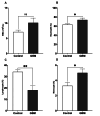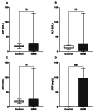Mutations in the TP53, VEGFA, and CTH Genes as Key Molecular Markers for the Diagnosis of Glioblastoma
- PMID: 38933650
- PMCID: PMC11202102
- DOI: 10.7759/cureus.61165
Mutations in the TP53, VEGFA, and CTH Genes as Key Molecular Markers for the Diagnosis of Glioblastoma
Abstract
Background Brain cancer, particularly glioblastoma (GBM), is a global health problem. Despite therapy advances, GBM patients have a poor prognosis. The progression and etiology of GBM may be linked to gene polymorphisms in the VEGFA, TP53, and CTH genes, among others. However, the genetic variations and their interaction in GBM are not fully understood. This study examines the effects of mutations in the VEGFA, TP53, and CTH genes on GBM. Methodology Tissue and blood samples were obtained for hematological, biochemical, and genetic analysis from 18 patients diagnosed with GBM as well as 28 healthy individuals. Standard methods were adopted to perform hematological and biochemical analyses, whereas mutational landscape and expression profiles were obtained from publicly accessible databases. Tissue samples were processed for genomic DNA extraction, and genotype determination was carried out through conventional polymerase chain reaction (PCR) and Sanger sequencing. Results The study involved 18 patients with grade IV GBM before treatment and 28 healthy individuals. The patients consisted of 11 men (61%) and seven females (39%), while healthy individuals included 14 (50%) males and 14 (50%) females. Sixty-seven percent of patients were under 50, 17% between 51 and 60, and 17% over 61, compared to healthy individuals who were 61% under 50, 7% between 51 and 60, and 32% over 60. GBM patients showed higher neutrophil and monocyte counts (median 81% (63.9, 83.5) and 4.2% (3.8-7.3)), respectively, and lower lymphocyte counts (median 13.4% (8.8, 28.40)) compared to controls. The median values of aspartate transaminase (AST), alanine transaminase (ALT), and alkaline phosphatase (ALP) showed no significant differences between the control and GBM groups. GBM patients had significantly higher median CRP levels of 2.55 (1.6, 98) than controls. Analysis of databases revealed a high prevalence of mutations in TP53, with splice region variants, missense variants, and intron variants being the most common. VEGFA and CTH also displayed mutations, primarily missense and intron variants. Gene expression analysis showed significantly higher levels of TP53 and VEGFA in GBM patients compared to controls. CTH expression also exhibited a slight increase in GBM patients. Sanger sequencing identified three mutations in the TP53 gene, including a novel mutation (11915C>A) not previously reported in external databases. Additionally, novel mutations were found in the VEGFA (841G>GA, 919T>TG) and CTH (28398A>AC, 28399A>AT) genes. Conclusions This study highlights the immune dysregulation, inflammation, and genetic variations in GBM. The findings emphasize the potential importance of the TP53, VEGFA, and CTH genes as targets for therapies and diagnostic biomarkers of GBM. Further study is necessary to comprehend these genetic variations' functional implications and their use in personalized GBM treatment.
Keywords: cth; gene mutation; glioblastoma; tp53; vegfa.
Copyright © 2024, Khalil et al.
Conflict of interest statement
Human subjects: Consent was obtained or waived by all participants in this study. Scientific Research Division's Research Ethics Committee of University of Duhok issued approval 15092021-9-13. All procedures contributing to this work met national and institutional human experimentation committees' ethical standards and the Declaration of Helsinki. Animal subjects: All authors have confirmed that this study did not involve animal subjects or tissue. Conflicts of interest: In compliance with the ICMJE uniform disclosure form, all authors declare the following: Payment/services info: All authors have declared that no financial support was received from any organization for the submitted work. Financial relationships: All authors have declared that they have no financial relationships at present or within the previous three years with any organizations that might have an interest in the submitted work. Other relationships: All authors have declared that there are no other relationships or activities that could appear to have influenced the submitted work.
Figures



Similar articles
-
Correlation of genetic alterations by whole-exome sequencing with clinical outcomes of glioblastoma patients from the Lebanese population.PLoS One. 2020 Nov 25;15(11):e0242793. doi: 10.1371/journal.pone.0242793. eCollection 2020. PLoS One. 2020. PMID: 33237934 Free PMC article.
-
Mutations in Genes Producing Nitric Oxide and Hydrogen Sulfide and Their Connection With Apoptotic Genes in Chronic Myeloid Leukemia.Cureus. 2024 Jun 3;16(6):e61570. doi: 10.7759/cureus.61570. eCollection 2024 Jun. Cureus. 2024. PMID: 38962618 Free PMC article.
-
Detection of gene mutations and gene-gene fusions in circulating cell-free DNA of glioblastoma patients: an avenue for clinically relevant diagnostic analysis.Mol Oncol. 2022 May;16(10):2098-2114. doi: 10.1002/1878-0261.13157. Epub 2022 Feb 11. Mol Oncol. 2022. PMID: 34875133 Free PMC article.
-
TP53 Mutation and Extraneural Metastasis of Glioblastoma: Insights From an Institutional Experience and Comprehensive Literature Review.Am J Surg Pathol. 2021 Nov 1;45(11):1516-1526. doi: 10.1097/PAS.0000000000001762. Am J Surg Pathol. 2021. PMID: 34366423 Review.
-
Glioblastoma Multiforme and Genetic Mutations: The Issue Is Not Over Yet. An Overview of the Current Literature.J Neurol Surg A Cent Eur Neurosurg. 2020 Jan;81(1):64-70. doi: 10.1055/s-0039-1688911. Epub 2019 Sep 24. J Neurol Surg A Cent Eur Neurosurg. 2020. PMID: 31550738 Review.
References
-
- Global cancer statistics 2020: GLOBOCAN estimates of incidence and mortality worldwide for 36 cancers in 185 countries. Sung H, Ferlay J, Siegel RL, Laversanne M, Soerjomataram I, Jemal A, Bray F. CA Cancer J Clin. 2021;71:209–249. - PubMed
-
- The 2021 WHO classification for gliomas and implications on imaging diagnosis: part 1-key points of the fifth edition and summary of imaging findings on adult-type diffuse gliomas. Park YW, Vollmuth P, Foltyn-Dumitru M, Sahm F, Ahn SS, Chang JH, Kim SH. J Magn Reson Imaging. 2023;58:677–689. - PubMed
LinkOut - more resources
Full Text Sources
Research Materials
Miscellaneous
